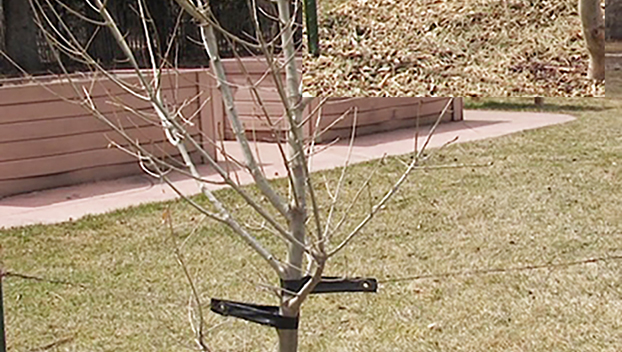MASTER GARDENER — Transplanting trees: When it’s hot, it’s not
Published 12:06 am Tuesday, July 4, 2023

- Staking trees is an often overlooked gardening task but necessary to maintain a tree’s structural growth and root stability. Allow stakes to remain attached to the tree for two years of growth. (cheyennegardengossip.wordpress.com)
|
Getting your Trinity Audio player ready...
|
Wow, can you believe how rapidly this year is advancing? Half the year is already behind us, and we have now celebrated our 247th Independence Day!
Hopefully each of you celebrated with neighbors, family and friends, utilizing the traditions your families have created for such a momentous occasion.
Today, our discussion will be centered on ‘best practices’ for planting trees in SETX and timing. Let’s ‘dig in’ (pun intended) but want to lead into the discussion by saying it is not the correct time of year for us to be planting trees, as it’s simply too hot!
Trending
Naturally, I purchased too many plants (including numerous trees-don’t roll your eyes, some of you did the exact same thing) this spring and ran out of time before I could get them each planted into the ground.
It is imperative that the initial step, before digging to plant a tree or other type excavation work is by dialing 811 (national call-before-you-dig) phone number requesting that the approximate location of buried utilities be marked with paint or flags, so you don’t unintentionally dig into an underground utility line.
This will usually take a couple of days for utility companies to send out crews to mark the locations. Once the lines are marked, select a planting location away from overhead electrical lines based upon the tree’s mature height but should be in full sun. Note if you plant the tree too close to electrical lines it will be ‘shaped’ for you, and I can guarantee you it’s not going to be attractive!
The optimal tree planting time is autumn through winter, while the tree is dormant, as this provides the tree time to develop a robust root system, while not expending energy to grow leaves.
Instead, the tree can put all its energy into growing roots. Trees need space to grow, not only for their canopy spread, but also for their even more expansive root system beneath the soil. Roots don’t migrate straight downward and have small, delicate roots radiating away from the taproot near the soils surface.
These smaller roots capture nutrients and uptake water. Compaction of the soil around trees damages these small, delicate, sensitive roots, easily stressing the tree that will suffer and eventually die.
If the root ball is dry, soak it overnight before planting. The guidelines below will assist you in determining space requirements for tree roots:
- Small size trees need at least 10 feet by 10 feet
- Medium size trees need 20 feet by 20 feet
- Large size trees need at least 30 feet by 30 feet
Now that the perfect planting site is selected, gather the following items which are necessary to plant a tree: knife or scissors, paperboard box, tarp or wheelbarrow, hammer, shovel, bracing stakes and rope, wrapping material (such as old water hose cut into 12-inch sections) to prevent damage from string trimmers and rope burn when staking, compost, composted manure and mulch.
Once the tools and other items are on hand, let the fun begin! Dig a hole 2 to 3 times the size of the root ball or container (I use the trees container as a guide when digging the hole) but do not dig deeper than the top of the root ball.
If planted too deeply the root system will be deprived of oxygen, weakening the tree, and increasing the likelihood of disease forming.
Ensure the soil removed from digging is captured, and placed onto a paperboard box, tarp, or wheelbarrow. Since most of us in SETX have clay soil, my recommendation is loosening the soil another 6 to 8-inches deeper, which allows tree roots to grow more readily, unencumbered by compacted soil.
Mix half the removed soil with equal parts of compost and composted manure, then add 1/3 of the amended soil mixture into the bottom of the hole, then gently remove the tree from the nursery pot by cutting away the plastic pot using a knife or scissors, this is less destructive to the root system and a better choice than ‘tugging’ on the tree to free it from the pot!
Often the roots are tightly wound and a compact the root ball has formed, if this is the case, gently untangle the roots to loosen them and visually inspect the top of the root ball to ensure there are no roots encircling the trunk, they will strangle the tree if not removed.
If the tree is ‘bare root’ or ‘burlap’ wrapped, inspect the roots and look for “J-shaped” roots, they will need to be straightened, if possible, when planting to allow the roots to grow downward. Begin filling the hole, alternating layers with the amended soil mixture, followed by a layer of soil removed from the hole.
The nutrient rich compost and composted manure provides the tree with the benefits of easily accessible nutrients from the soil amendments, while it adapts to the new growing environment. Gently tamp the soil into place, firmly but not severely, slightly compressing the soil when filling the hole.
There should be a good bit of soil remaining after planting the tree, use all of it to build a 4 to 6-inch berm around the perimeter of the newly planted tree.
Fill the berm with mulch, shredded bark, or compost, as this becomes a moisture barrier adding in water retention while diminishing weeds from growing. Many gardeners believe that staking is not necessary, I completely disagree!
I encourage gardeners to always place stakes on either side of a newly planted tree to stabilize the tree for two years. This is going to protect your investment of time, money, and energy! Staking trees allow the roots to stabilize when growing, especially during the windy wintery months.
Once the tree is planted, fill the berm 2 or 3 times with water, and allow the water to penetrate the soil to the root ball. The initial two weeks after planting the tree will require light watering daily and should be provided about a quart of water.
The 2nd and 3rd week increase water volume to two quarts of water every other day. The 4th week the water volume increases to 3 quarts every 3rd day and beginning the 5th week, water on an as needed basis.
The goal is to diminish watering completely (except during drought conditions), forcing the root system to grow stronger by making the roots search for water deeply into the soil. Note that I do not recommend fertilizing a newly planted tree the first year, since over-fertilizing will damage the root ball which might kill the tree or severely injure it.
So long for now fellow gardeners, let’s go out and grow ourselves a greener, more sustainable world, one plant at a time.
Thank you for your recent questions, I enjoy answering each and every one of them!
John Green is Texas Certified Master Gardener with Orange County Master Gardeners. If you have gardening questions, email jongreene57@gmail.com or phone the Orange County Master Gardeners Helpline at 409-882-7010.



